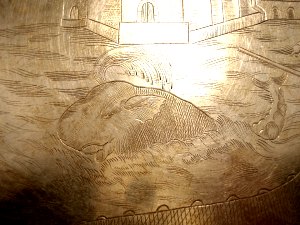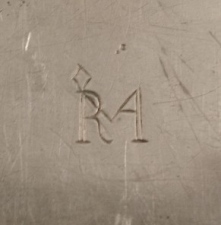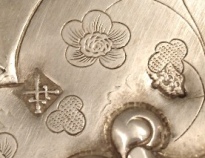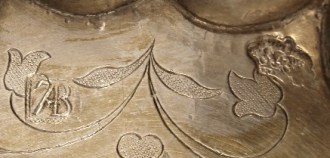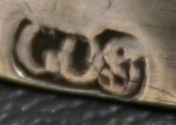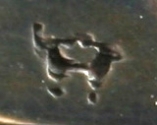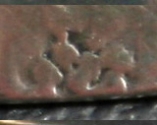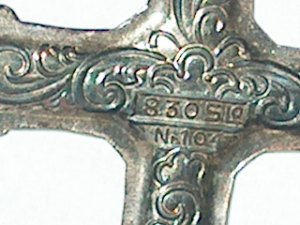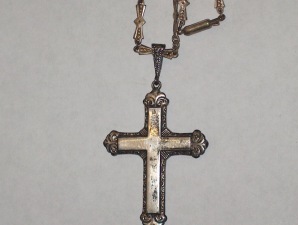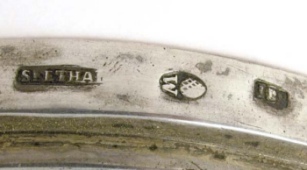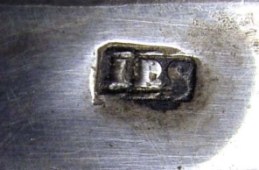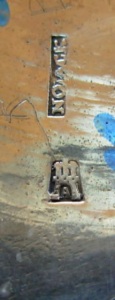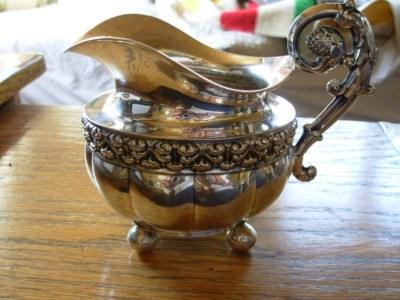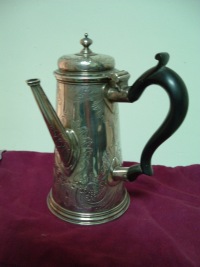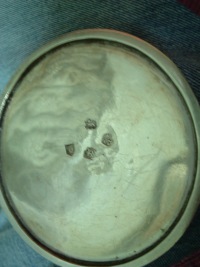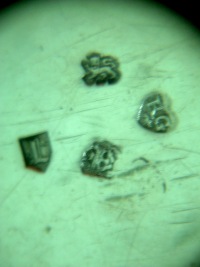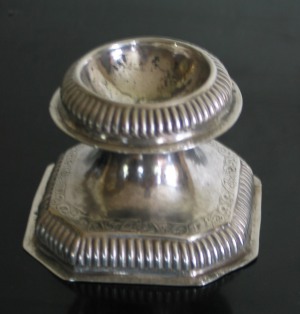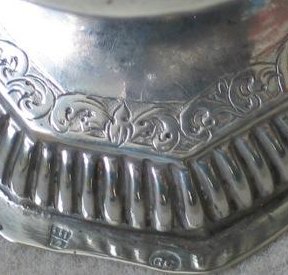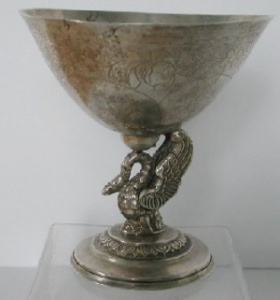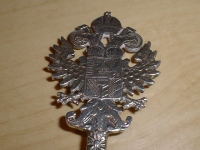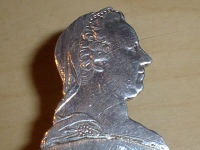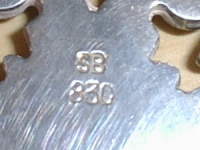 newsletter # 26 June 2006
newsletter # 26 June 2006www.ASCASonline.org
email: silverassociation@yahoo.it
YOUR GUIDE TO THE JUNE NEWSLETTER: new articles new members members' window questions replies a page per month bargain book contributors to June Newsletter search engine disclaimer and privacy policy
|
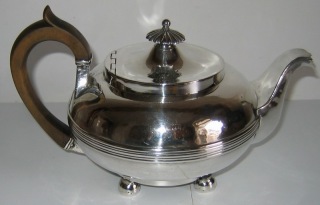 Giovanni Ciceri presents:
Giovanni Ciceri presents:History and marks of Hamilton & Co - Calcutta Storia e marchi di Hamilton & Co - Calcutta Robert Hamilton (1772-1848) arrived in India and started work in Calcutta in 1808. He opened his Jewellery and Silversmithing shop at 5 Tank Square in 1808 under licence from the East Indian Company. In this article Giovanni Ciceri presents a brief history of the Hamilton firm and an interesting study of its marks from 1811 to 1973. English |
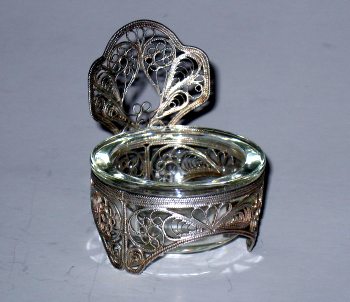 Willand Ringborg presents:
Willand Ringborg presents: Soviet time silver salts - semi antique to come? The extraordinary silver and jewellery craftsmanship in Russia during the 19th and the early 20th centuries was dashed to the ground by the revolution and World War I. However, after World War II, a minor reappearance of silver pieces for general sale became visible, but organized the soviet way – industrialized production by all-union plants delivering to the entire Soviet. In this article Willand Ringborg presents a small selection of silver salts and salt spoons of the Soviet era. click here |
New members
Welcome to new ASCAS members:
Peter Brocks - USA
Diane Cass - USA
Philippe d'Arschot - Belgium
Kari Helenius - Finland
Carolyn Henry - USA
David Herman - USA
Carol Kelley - USA
Geraldine Kempe - USA
Eleanor Lee Gaunt - USA
Roberta Markow - USA
Thomas Martin - Argentina
Carol Marvos - USA
Teresa Masters - USA
Pat Turner - USA
Diane C. Wachs - USA
Members' Window # 26
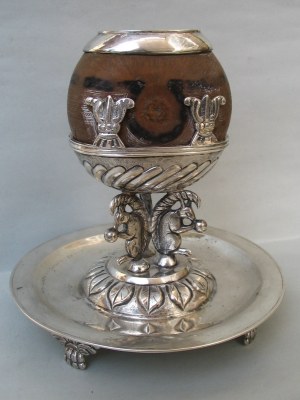
Giorgio Busetto presents: A silver mate from South America Maté is a word of 'quichua' origin (mati) that identifies a vase used for drinking. In Peru and Rio de la Plata maté is the name of calabash tree fruit ( 'Lagenaria vulgaris') used to contain an infusion of herbs originating in Paraguay (Olex Paraguariensis). As rhe use of this container spread through South America, the name of the vessel (mate) also became associated with name of the drink (Yerba Mate). Giorgio Busetto presents his unmarked silver mate with the calabash cup supported by three squirrels and resting on a three footed dish. Its origin may possibly be attributed to Chili or Cuyo (Argentina), middle of the 19th century. click here |
Questions from ASCAS members
David Elyea writes:
...... I would very much like to join your association. My name is David Elyea of Richmond
Virginia. I also have a silver tray that I have owned for quite a while. I was hoping that one
of your members might recognize the marks and know the approximate age.
I believe it is at least 19th century, if not much older. It measures 20" by 14" and the center
is hand engraved with a fishing scene with whale. There are three hallmarks: crossed swords,
crown and 'AB' mark.
The back is engraved with a mark which looks like 'RMA', and 'M. de Jesus Roma de A.'
Any information would be very helpful. Thank you.
David Elyea
Richard L. Christiansen writes
.....We would like to find an authoritative source that could identify the origins of this
silver cup we believe was made in Dalarna in the period between 1742-1820.
Thank you for your assistance.
Richard L. Christiansen
Sharon Bares writes:
... Could you please help me identify the maker and date of this item? It is an old
Norwegian Solje cross with a maker's mark that looks like a capital L with a lower case o
inside the L and it is also marked as 'no.104'.
I cannot find any information about this piece. I hope someone can help.
Sincerely,
Sharon Bares
Paulina Wojdak writes:
... I have a problem with one mark. I've heard that this object is silver, comes from early
19th century and that it could be made by silver workers from Augsburg. Could you help me to
identify the marks please.
I accompany the letter by the photos. Thank you very much indeed.
Best regards from Poland.
Paulina Wojdak
Carl Heimann writes:
... Is this Hallmark from Hamburg 1802? Tardy is a little inexact....
Michael Blake writes:
.... Please can you help me as I am finding it very difficult to make sense of it.
It is quite a small pot, standing only 18 centimetres to the top of the lid. The hallmarks
appear to be for 1668, but the makers mark seems to be Richard Green (early 18th century?).
Having said that, the mark is not identical to the example of his mark that I have seen. (The
mark is similar in that it is R G inside a heart shape, yet the letters are different and the
shape beneath is also different.)
If they are his marks, could he have done some work on this earlier pot, ( the chasing for
instance) and then added his mark to the existing hallmarks?
I have attached some pictures and would be very grateful for your comments.
Regards,
Michael Blake
I’m unable to help you as I have not a great knowledge of English Silver.
According to Geoffrey Wills, the earliest recorded coffee pot is one of 1681 in the Victoria
& Albert Museum. Your coffee pot is made in 18th century style and I believe that in 1668
coffee was not used in private houses. I hope that ASCAS members will be able to help you.
Giorgio Busetto
Replies to members' questions
Svein Solhjell receives this reply about his silver salt cellar ( see May Newsletter) Karin Sixl-Daniell writes: .... this appears to me to be a mid 18th century piece and the hallmarks point to
Cologne. The 12 stands for 12 lot which equals a silver content of 750. Unfortunately,
I do not have information about the maker indicated on this piece.
Charles C. Cage writes:
|
| Hymie Dinerstein
receives this reply about his silver bowl on Members' window # 25 on
May Newsletter Martha Gaber Abrahamsen writes: I was naturally interested in seeing the article on the Danish bowl by Hymie
Dinerstein, but I think her conclusion that it was made to commemorate Hans Christian
Andersen's fairy tale 'The Ugly Duckling' is unfounded. |
Ian Crowland receives this reply about his silver piece ( see May Newsletter) Karin Sixl-Daniell writes: .... The answer to the question is that the piece is made of an Austrian coin - it is
cut out of a coin (Maria-Theresien Taler). The part with eagles is the Austrian Imperial
coat of arms and the head depicts the famous Empress Maria Theresia (1717-1780). |
"A page per month"
In this column we present a page (one
page only) obtained from makers' brochures, books, auction
catalogs or whatever other printed paper, which may be of
particular interest for ASCAS members.
The images will be published at a "low resolution" level and for
private and personal use only

|
This month
ASCAS presents the images of a six piece tea and coffee set and tray, table XX of
the 1893 catalog of the 'Maison Boin-Taburet - fabricant orfévre joaillier à Paris':
|
An interesting bargain
Marilyn Eustace writes:.... Thank you for your newsletter.
I would like to inform you that there is a wonderful book available on English, Irish, and
Scottish Silver, compiled by Beth Carver Wees of the Clark Art Institute. Normally this book is
US $125 but the Art Institute has it on sale for $29.98. It has pictures of and describes the
marks of all the pieces.
I thought it was a great bargain, but it is heavy!!
Sincerely, Marilyn Eustace
The Sterling and Francine Clark Art Institute is an art museum and a center for research
and higher education, dedicated to advancing and extending the public understanding of art.
I believe that this information may interest ASCAS members and is not in conflict with the
'non commercial' mission of ASCAS.
I have just ordered the book at
http://shop.store.yahoo.com/clarkart/enirscotsila.html
I was requested of $ 15 for shipping to Italy (ground)
Giorgio Busetto
Closing our JUNE 2006 edition of ASCAS
Newsletter I hope you have appreciated its content.
Your comments, suggestions and advice will be of great help.
My thanks to Sharon Bares, Michael Blake, Charles C. Cage (USA), Giovanni Ciceri (Italy), Richard L. Christiansen,
Jayne Dye (USA), David Elyea (USA), Marilyn Eustace (Canada), Martha Gaber Abrahamsen (Denmark),
Carl Heimann (USA), Willand Ringborg (Sweden), Karin Sixl-Daniell (Austria), Paulina Wojdak (Poland) for their invaluable
contributions.
Giorgio Busetto
Secretary
ASCAS is a community of people having a common
interest in antique silver.
|



